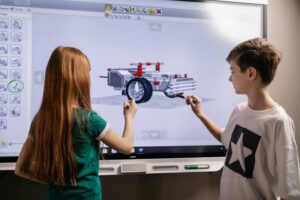
Robotics is no longer confined to research labs or factories—it has become an integral part of modern education. By introducing children to robotics, we’re equipping them with technical skills, creative thinking, and problem-solving abilities that are essential in the 21st century. Robotics education not only prepares kids for tomorrow’s careers but also helps them become innovative thinkers and lifelong learners.
1. Why Robotics Matters in Today’s World
The world is becoming increasingly reliant on automation and robotics, from healthcare to transportation. Introducing kids to robotics early helps them understand these technologies and prepares them for future challenges.
By learning how robots work, kids gain insights into engineering, programming, and the role of technology in solving global problems.
2. Hands-On Learning for Deeper Understanding
Unlike traditional learning methods, robotics education is inherently hands-on. Kids actively build, program, and test robots, applying theoretical knowledge to practical tasks.
This experiential learning approach strengthens their understanding of STEM concepts and fosters curiosity and innovation.
3. Developing Problem-Solving Skills
Every robotics project is a challenge, requiring kids to design, troubleshoot, and optimize their creations. These tasks teach them critical problem-solving skills, encouraging logical thinking and perseverance.
For example, programming a robot to navigate a maze teaches kids to break complex problems into manageable steps, a skill they can apply in any field.
4. Encouraging Creativity and Innovation
Robotics combines science and creativity. Kids are not just assembling parts; they’re designing solutions and innovating new ways to tackle tasks.
From creating robots that clean up spills to designing automated delivery systems, students are encouraged to think outside the box and explore their creative potential.
5. Building Teamwork and Collaboration Skills
Robotics projects often involve group work, where kids brainstorm ideas, divide tasks, and solve problems together.
This collaborative environment teaches them how to work as part of a team, communicate effectively, and appreciate diverse perspectives—skills that are essential in any professional setting.
6. Introducing Coding in a Fun and Engaging Way
Robotics education often involves programming, introducing kids to coding in a fun and interactive manner.
Through platforms like Scratch, Blockly, or Python, kids learn to write scripts that control robot movements, lights, and sensors. This gamified approach makes coding enjoyable and accessible, even for beginners.
7. Inspiring Future Careers in STEM
Robotics education exposes kids to fields like engineering, AI, and automation, sparking interest in STEM careers.
By engaging with robots, kids can envision themselves as future scientists, engineers, or innovators, paving the way for fulfilling and impactful careers.
8. Preparing for the Future Workforce
Automation and robotics are transforming industries, creating demand for professionals skilled in robotics, coding, and AI.
Teaching kids robotics equips them with in-demand skills, making them future-ready and giving them a competitive edge in tomorrow’s job market.
Our Commitment to Robotics Education
At our organization, we believe robotics is more than just a subject—it’s a gateway to innovation. Our robotics programs are designed to teach kids the fundamentals of engineering, coding, and problem-solving through engaging, hands-on projects.
With experienced mentors, state-of-the-art tools, and a curriculum tailored to young learners, we ensure every child enjoys learning while building skills for life.
Conclusion
Robotics in education is about more than building machines—it’s about shaping the innovators of tomorrow. By teaching kids robotics, we’re not just giving them technical skills; we’re inspiring creativity, resilience, and a passion for solving real-world problems.
Join us in empowering the next generation of problem-solvers and creators. Explore our robotics programs today!